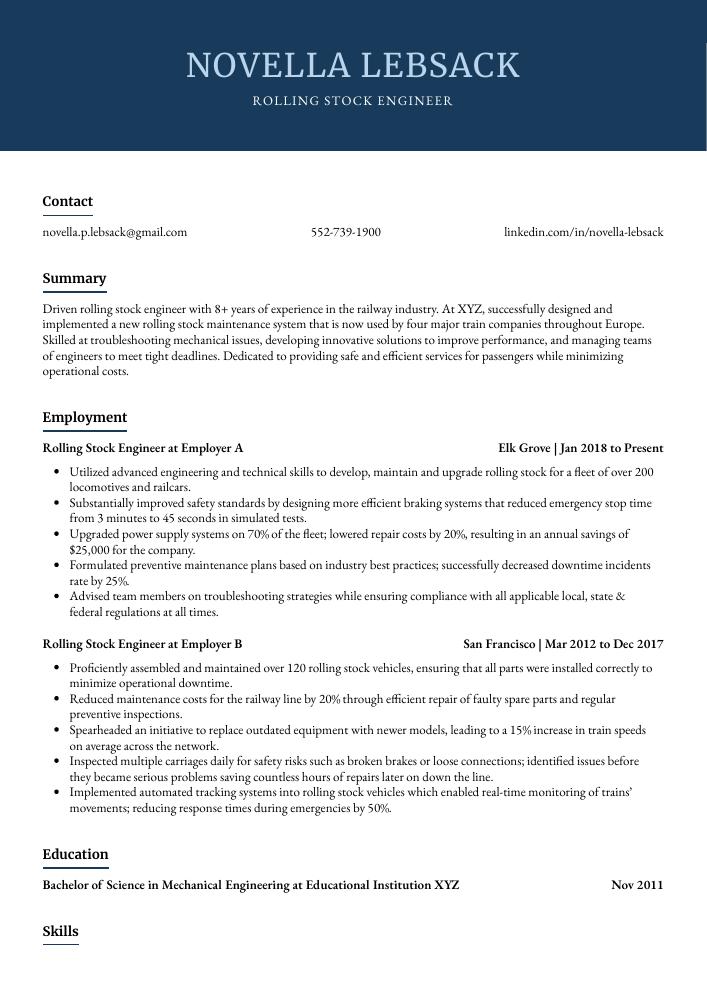Rolling Stock Engineer Resume Guide
Rolling stock engineers inspect, maintain, and repair railway vehicles such as locomotives and passenger carriages. They ensure that the rolling stock is safe to use by performing regular checks on its mechanical components, electrical systems, brakes, wheelsets and other equipment. Additionally they carry out modifications or replacements of parts when necessary in order to keep the vehicle running smoothly.
You have the technical expertise to maintain and repair rolling stock, but employers don’t know that yet. To make them aware of your impressive engineering skills, you must compose a resume that stands out from the crowd.
This guide will walk you through the entire process of creating a top-notch resume. We first show you a complete example and then break down what each resume section should look like.
Table of Contents
The guide is divided into sections for your convenience. You can read it from beginning to end or use the table of contents below to jump to a specific part.
Rolling Stock Engineer Resume Sample
Novella Lebsack
Rolling Stock Engineer
[email protected]
552-739-1900
linkedin.com/in/novella-lebsack
Summary
Driven rolling stock engineer with 8+ years of experience in the railway industry. At XYZ, successfully designed and implemented a new rolling stock maintenance system that is now used by four major train companies throughout Europe. Skilled at troubleshooting mechanical issues, developing innovative solutions to improve performance, and managing teams of engineers to meet tight deadlines. Dedicated to providing safe and efficient services for passengers while minimizing operational costs.
Experience
Rolling Stock Engineer, Employer A
Elk Grove, Jan 2018 – Present
- Utilized advanced engineering and technical skills to develop, maintain and upgrade rolling stock for a fleet of over 200 locomotives and railcars.
- Substantially improved safety standards by designing more efficient braking systems that reduced emergency stop time from 3 minutes to 45 seconds in simulated tests.
- Upgraded power supply systems on 70% of the fleet; lowered repair costs by 20%, resulting in an annual savings of $25,000 for the company.
- Formulated preventive maintenance plans based on industry best practices; successfully decreased downtime incidents rate by 25%.
- Advised team members on troubleshooting strategies while ensuring compliance with all applicable local, state & federal regulations at all times.
Rolling Stock Engineer, Employer B
San Francisco, Mar 2012 – Dec 2017
- Proficiently assembled and maintained over 120 rolling stock vehicles, ensuring that all parts were installed correctly to minimize operational downtime.
- Reduced maintenance costs for the railway line by 20% through efficient repair of faulty spare parts and regular preventive inspections.
- Spearheaded an initiative to replace outdated equipment with newer models, leading to a 15% increase in train speeds on average across the network.
- Inspected multiple carriages daily for safety risks such as broken brakes or loose connections; identified issues before they became serious problems saving countless hours of repairs later on down the line.
- Implemented automated tracking systems into rolling stock vehicles which enabled real-time monitoring of trains’ movements; reducing response times during emergencies by 50%.
Skills
- Railway Signaling Systems
- Track Maintenance
- Train Control Systems
- Locomotive Engineering
- Rolling Stock Design
- Railway Operations
- Railway Safety Systems
- Electrical Engineering
- Railway Infrastructure
Education
Bachelor of Science in Mechanical Engineering
Educational Institution XYZ
Nov 2011
Certifications
Certified Rolling Stock Engineer
American Association of Railroads
May 2017
1. Summary / Objective
A resume summary for a rolling stock engineer should be crafted to give the hiring manager an overview of your experience and qualifications. Include information such as how long you have been in the field, any relevant certifications or licenses you hold, and examples of successful projects that demonstrate your technical expertise. Additionally, mention any awards or recognition you have received for outstanding performance on the job.
Below are some resume summary examples:
Skilled rolling stock engineer with 7+ years of experience in the railway industry. Specialized in developing and testing innovative solutions to improve ride quality, optimize maintenance cycles, and reduce costs. At XYZ Corporation, led a team that designed new rolling stock components for an improved passenger transportation system resulting in 10% cost savings year-over-year. Proven track record of successful commissioning projects from concept to realization within budget constraints.
Detail-oriented Rolling Stock Engineer with 8+ years of experience in the rail industry. Expertise in developing rolling stock designs, analyzing technical specifications and requirements, as well as safety regulations compliance. At XYZ Corporation, led a team of 10 engineers to develop 5 new train models which were launched successfully within 2 months ahead of schedule. Looking to join ABC Railways to continue innovating on engineering solutions for their fleet operations.
Passionate Rolling Stock Engineer with 8+ years’ experience in the railway industry. Possesses a deep understanding of rolling stock mechanics and operations, including maintenance, repair, modification and inspection procedures. At XYZ Railway Company successfully completed a major overhaul project for the fleet that reduced downtime by 25%. Highly skilled at developing cost-effective solutions to ensure optimal performance and reliability of equipment.
Energetic rolling stock engineer with 8+ years of experience in the rail industry. Experienced in developing rolling stock designs, evaluating their performance and improving them for a safer transit system. At XYZ, worked on several projects involving high-speed trains and freight wagons to provide reliable services throughout Europe. Successfully reduced assembly time by 20% while ensuring safety standards were met or exceeded at all times.
Enthusiastic rolling stock engineer with five years of experience in the design, maintenance and repair of trains. At XYZ Railways, worked on a team responsible for increasing operational efficiency by 20%. Proven record of successful project management from concept to delivery. Experienced in troubleshooting complex issues related to rolling stock engineering including mechanical and electrical systems.
Diligent rolling stock engineer with 5+ years of experience in maintenance, repairs and overhauls for railway vehicles. Seeking to join ABC Railways as a rolling stock engineer and leverage my expertise in troubleshooting complex issues related to locomotives, carriages and wagons. At XYZ Ltd. , successfully implemented cost reduction measures that resulted in an 18% decrease in overhead costs.
Professional rolling stock engineer with 5+ years of experience in the railway industry. Skilled at analyzing vehicle performance, troubleshooting system issues and developing cost-effective solutions to improve maintenance operations. Seeking a role in ABC Rail that utilizes my expertise to maximize efficiency and ensure customer satisfaction through improved quality assurance processes.
Accomplished rolling stock engineer with 8+ years of experience in the rail industry. Skilled at conducting design, engineering and project management activities for successful delivery of projects on time and within budget. Seeking to join ABC Railways where I can apply my expertise in railway systems rolling stock maintenance, refurbishment, overhauling and modernization.
2. Experience / Employment
Next comes the work history section, which should be written in reverse chronological order, with your most recent job listed first.
When writing this section, you want to use bullet points and provide detail on what you did. This allows the reader to quickly take in the information while also giving them an idea of how successful you were at each role.
For example, instead of saying “Worked on rolling stock,” you could say, “Repaired and maintained over 50 locomotives per month for a major railroad company; reduced repair costs by 10% through improved maintenance practices.”
To write effective bullet points, begin with a strong verb or adverb. Industry specific verbs to use are:
- Designed
- Installed
- Inspected
- Operated
- Troubleshot
- Calibrated
- Programmed
- Assembled
- Commissioned
- Monitored
- Tested
- Adjusted
- Repaired
- Replaced
- Upgraded
Other general verbs you can use are:
- Achieved
- Advised
- Assessed
- Compiled
- Coordinated
- Demonstrated
- Developed
- Expedited
- Facilitated
- Formulated
- Improved
- Introduced
- Mentored
- Optimized
- Participated
- Prepared
- Presented
- Reduced
- Reorganized
- Represented
- Revised
- Spearheaded
- Streamlined
- Structured
- Utilized
Below are some example bullet points:
- Demonstrated superior knowledge of rolling stock engineering principles in the design and installation of over 200km/h high-speed rail systems; completed projects 10% ahead of schedule.
- Programmed complex computerized monitoring systems to identify potential mechanical issues with trains and carriages, preventing downtime by 25%.
- Designed innovative solutions for emergency braking & power distribution problems, leading to a $250K reduction in maintenance costs per quarter.
- Monitored existing train fleets on a daily basis while providing technical advice when needed; rectified 50+ small faults within 24 hours that would have otherwise led to delays or cancellations.
- Confidently provided professional guidance regarding railway safety protocols for multiple large-scale construction projects across the country, ensuring compliance with all relevant regulations at all times.
- Tested and maintained rolling stock equipment, ensuring that all vehicles were in excellent working order and compliant with safety regulations; reduced breakdowns by 20%.
- Facilitated the design of new train models to improve energy efficiency and reduce noise pollution levels; improved fuel economy by 10% over a 2-year period.
- Streamlined operations for an extensive network of rail lines across 3 states, cutting down on wait times for travelers by 25%; generated additional revenue of $500K annually through increased passenger traffic.
- Thoroughly analyzed potential risks associated with railway upgrades and identified cost-saving measures to ensure safe operation without compromising quality standards or endangering passengers’ lives; upgraded existing tracks at 40% lower costs than estimated budget figures while improving overall performance ratings from 72% to 90%.
- Reorganized maintenance schedules based on fleet usage data collected over 6 months, resulting in decreased operational downtime during peak hours while extending lifespan of rolling stock assets by 15%.
- Competently installed, tested and inspected rolling stock equipment in accordance with safety regulations to ensure optimum performance; improved efficiency by 17% while reducing maintenance costs by $5,000.
- Expedited the delivery of new components for railway systems in a timely manner; successfully completed 20+ projects within budget and ahead of schedule over four years.
- Structured regular maintenance programs on locomotives and other rail vehicles which increased reliability levels by 30%.
- Troubleshot technical issues with various types of train engines, identified solutions quickly and implemented repairs efficiently resulting in fewer delays caused due to mechanical problems or breakdowns.
- Developed comprehensive documentation processes that ensured smooth transition from one project phase to another as well as successful handover between teams working on different tasks related to railway engineering projects.
- Optimized rolling stock design and performance, improving efficiency by 10% and reducing operating costs by $4,000 a month.
- Presented new rolling stock designs to the management team for approval in line with company standards; successfully commissioned 4 new train models on schedule.
- Diligently monitored the maintenance of over 100 railway cars across 3 rail networks, ensuring that all components were inspected regularly to meet safety regulations.
- Participated in training sessions related to rolling stocks engineering practices as well as technical support staff development initiatives; achieved certification from professional body after completion of coursework modules within specified timeframe.
- Commissioned 2 locomotive projects at different sites while overseeing routine track inspections and repairs; completed final testing processes ahead of time without any issues reported during operations or malfunctions due to faulty equipments/installations.
- Calibrated and adjusted over 100 locomotive and rolling stock systems per week, ensuring that all vehicles were safe for operation; lowered defect rate by 15%.
- Prepared detailed reports on each vehicle’s performance during maintenance checks, including recommendations to improve safety and efficiency standards.
- Effectively managed a team of 10 mechanics in maintaining the condition of more than 300 railcars across 5 different lines; reduced downtimes by 25% with improved scheduling practices.
- Developed new procedures for inspecting brake systems and other components to ensure there are no defects before releasing them back into service; saved 1 hour/train check-up on average compared to old methods.
- Implemented an annual preventative maintenance program which resulted in 20% fewer breakdowns due to faulty equipment or improper handling techniques within 3 months.
- Improved rolling stock maintenance processes by 20%, resulting in a reduction of unscheduled downtime and increased on-time delivery performance.
- Revised rolling stock engineering designs for over 200 locomotives, wagons, carriages and other vehicles to meet new industry standards; resulted in improved safety ratings across the fleet.
- Consistently monitored operations of rolling stock systems and equipment to ensure optimal running conditions; identified potential issues before they caused major disruptions or delays.
- Represented organization at various national rail conferences as an expert speaker on emerging trends within the field of rolling stock engineering; introduced innovative developments that were later implemented company-wide with great success.
- Introduced cutting edge technologies into existing infrastructure projects which reduced time spent on repairs by 30% while also improving overall reliability levels throughout the entire network system.
- Compiled detailed reports on rolling stock performance and identified areas of improvement, resulting in a 10% increase in efficiency over the course of 6 months.
- Replaced worn parts on locomotives and railcars independently to ensure safe operation; decreased downtime by 35%.
- Independently coordinated preventive maintenance schedule for all rolling stock across multiple sites, ensuring that safety standards were met at all times.
- Coordinated with other engineers to troubleshoot issues related to signal systems, electrical wiring systems and motion control systems; successfully repaired an estimated 100+ malfunctions within one year alone.
- Repaired damaged freight cars using welding techniques according to industry guidelines; reduced delays due to mechanical failure by 20%.
- Operated and maintained rolling stock and associated infrastructure for a major railway network, ensuring that all safety standards were met at all times; reduced train delays by 20% in the last quarter.
- Actively monitored track conditions to identify areas of repair or improvement using advanced engineering software tools; identified 8 potential weak points along the line and successfully implemented solutions within budget.
- Achieved cost savings of $20,000 through effective planning and scheduling of maintenance activities across 10 stations each month while maintaining high service quality standards throughout operations.
- Assessed daily performance metrics such as wheel wear rate & brake efficiency to ensure optimal functioning of trainsets on long-distance routes with minimal downtime; improved rail reliability score by 15%.
- Mentored junior engineers on locomotive mechanics principles and practical implementation techniques during hands-on training sessions twice a week while managing 5 direct reports on various projects simultaneously.
3. Skills
Two organizations that have advertised for a position with the same title may be searching for individuals whose skills are quite different. For instance, one may require the candidate to be proficient in AutoCAD while another might prefer someone with experience using Catia.
It is important to tailor the skills section of your resume for each job you are applying for, as many companies use applicant tracking systems these days – computer programs that scan resumes and filter out those deemed not a good match based on certain keywords.
In addition to listing relevant skills here, you can further discuss them in other sections such as the summary or work experience area.
Below is a list of common skills & terms:
- Electrical Engineering
- Locomotive Engineering
- Railway Infrastructure
- Railway Operations
- Railway Safety Systems
- Railway Scheduling and Timetabling
- Railway Signaling Systems
- Rolling Stock Design
- Track Maintenance
- Train Control Systems
4. Education
Mentioning an education section on your resume depends on how far along you are in your career. If you just graduated and have no prior experience, mention your education below the resume objective. However, if you already have a good amount of work experience to showcase, an education section might not be necessary.
Including an education section is beneficial for those who don’t yet have much professional experience but want to emphasize their academic qualifications related to rolling stock engineering. Try mentioning courses or subjects that relate directly to the job at hand so employers know what type of knowledge base they can expect from you as a potential employee.
Bachelor of Science in Mechanical Engineering
Educational Institution XYZ
Nov 2011
5. Certifications
Certifications demonstrate to a potential employer that you have the knowledge and skills necessary for the job. They also show that you are committed to staying up-to-date with industry trends, as certifications often require ongoing education or renewal.
If your resume includes any relevant certifications, make sure they are prominently featured near the top of your document so employers can easily identify them.
Certified Rolling Stock Engineer
American Association of Railroads
May 2017
6. Contact Info
Your name should be the first thing a reader sees when viewing your resume, so ensure its positioning is prominent. Your phone number should be written in the most commonly used format in your country/city/state, and your email address should be professional.
You can also choose to include a link to your LinkedIn profile, personal website, or other online platforms relevant to your industry.
Finally, name your resume file appropriately to help hiring managers; for Novella Lebsack, this would be Novella-Lebsack-resume.pdf or Novella-Lebsack-resume.docx.
7. Cover Letter
A cover letter is a great way to make an impression on potential employers. It’s usually made up of 2 to 4 paragraphs and provides hiring managers with more information about you as a professional and individual than your resume alone can offer.
Writing one is not always mandatory, however it can be highly beneficial when applying for certain jobs or roles. A cover letter allows you to explain why you’re the best fit for the position in question, highlighting key skills and experiences that may have been overlooked in your CV.
Below is an example cover letter:
Dear Kaelyn,
I am writing in response to your ad for a Rolling Stock Engineer. With over 8 years of experience in the railroad industry, I am confident I have the necessary skills and qualifications to excel in this role.
In my current position as a Rolling Stock Engineer at XYZ Railroad, I am responsible for overseeing all aspects of rolling stock maintenance and repair. In addition, I have developed strong relationships with vendors and suppliers to ensure we are getting the best possible prices for parts and services. My ability to manage both people and budgets has resulted in significant cost savings for XYZ Railroad.
I am also proficient in computer-aided design (CAD) software, which is essential for creating accurate plans and drawings of rolling stock components. My CAD skills would be a valuable asset to your organization as you continue to modernize your fleet of locomotives and railcars.
As a highly skilled Rolling Stock Engineer, I am confident I will make an immediate contribution to Union Pacific Railroad’s engineering team. Please find attached my resume for your review, and do not hesitate to contact me at [phone number] or [email address] if you have any questions or need additional information about my qualifications. Thank you very much for your time; I look forward hearing from you soon!
Sincerely,
Novella
Rolling Stock Engineer Resume Templates
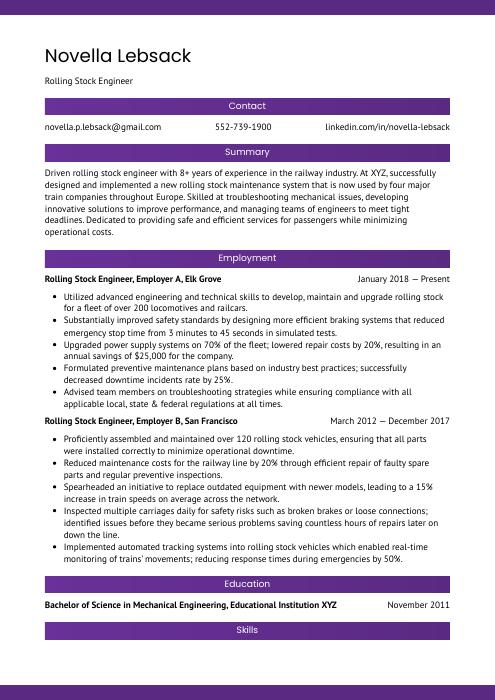 Jerboa
Jerboa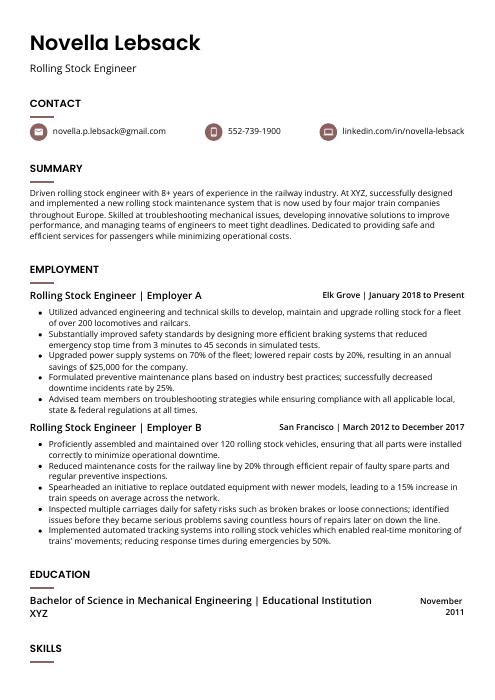 Fossa
Fossa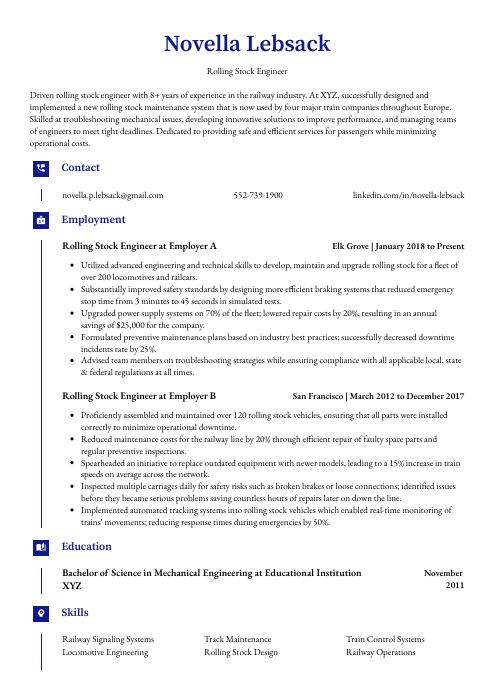 Gharial
Gharial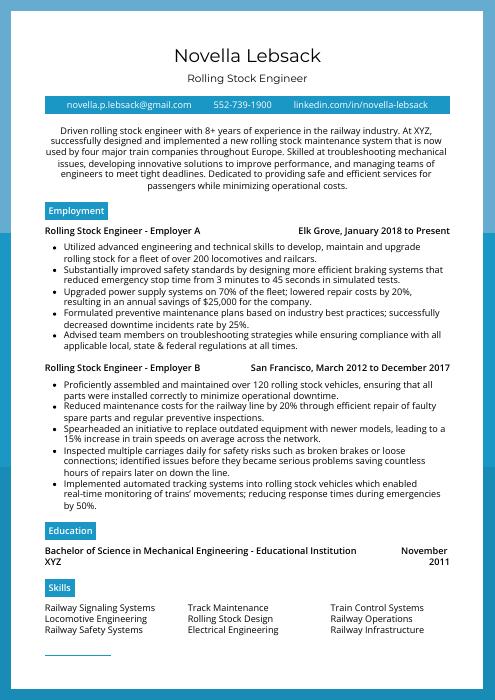 Rhea
Rhea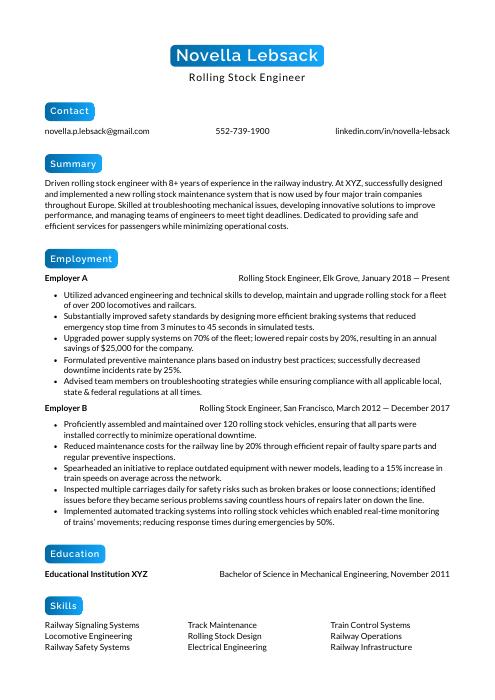 Kinkajou
Kinkajou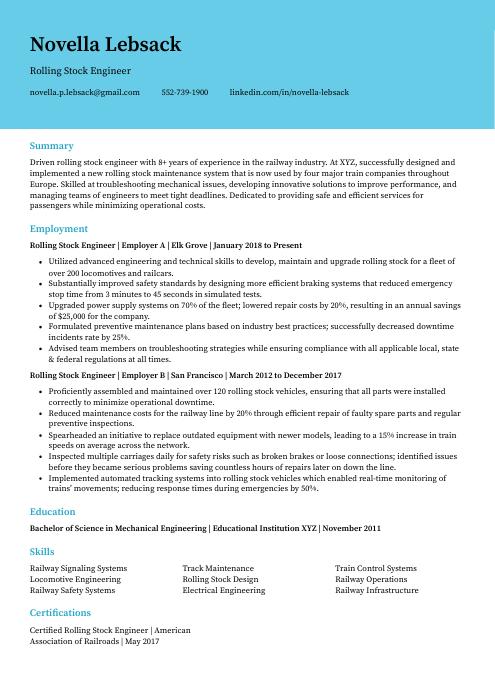 Dugong
Dugong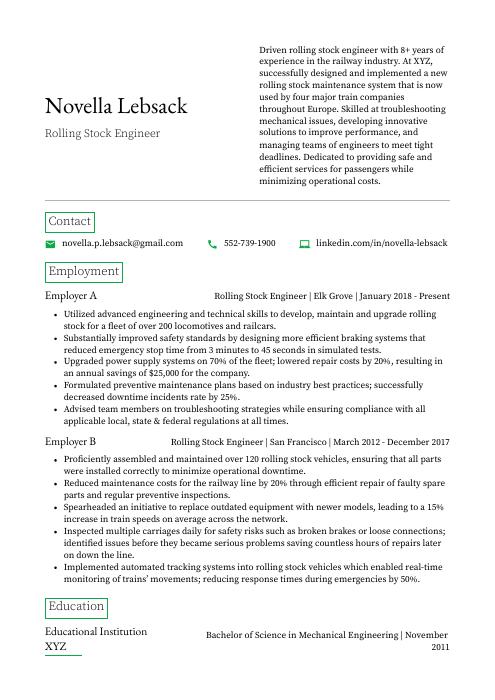 Quokka
Quokka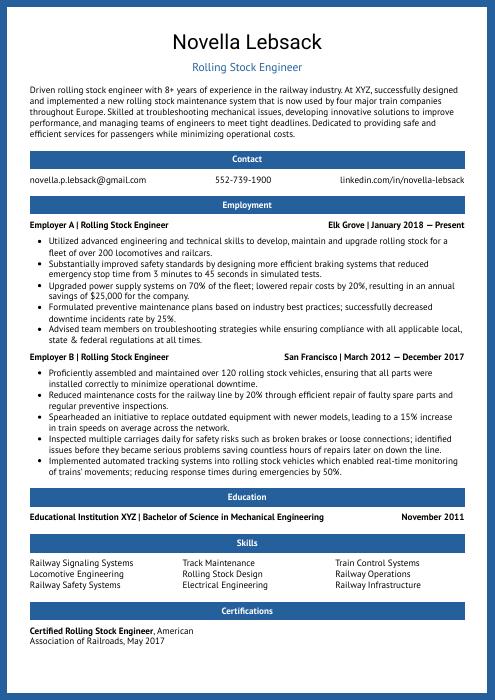 Ocelot
Ocelot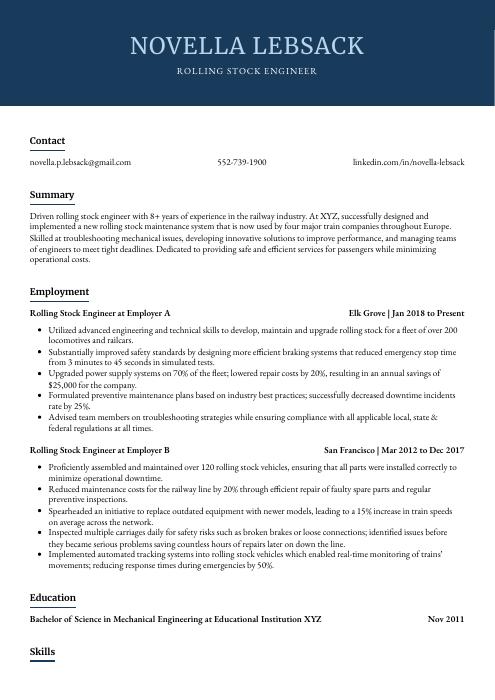 Bonobo
Bonobo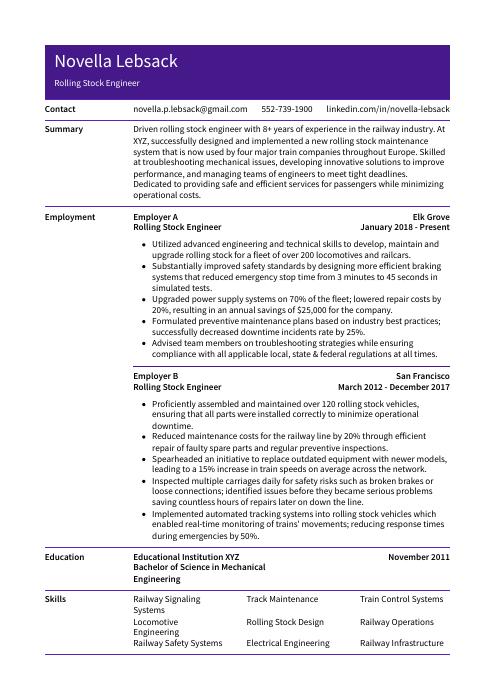 Pika
Pika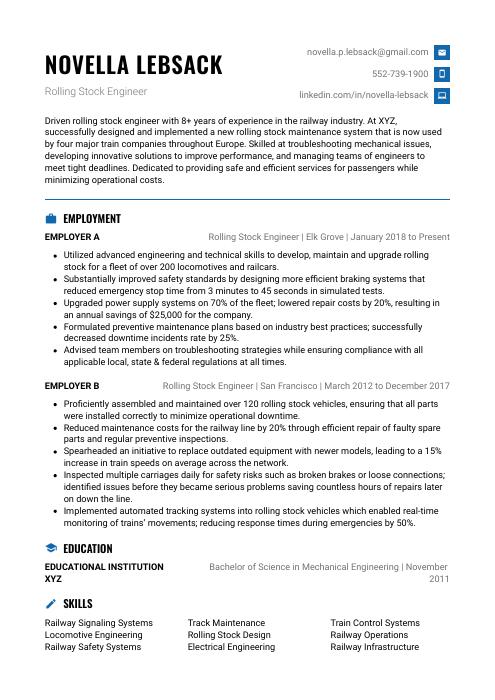 Echidna
Echidna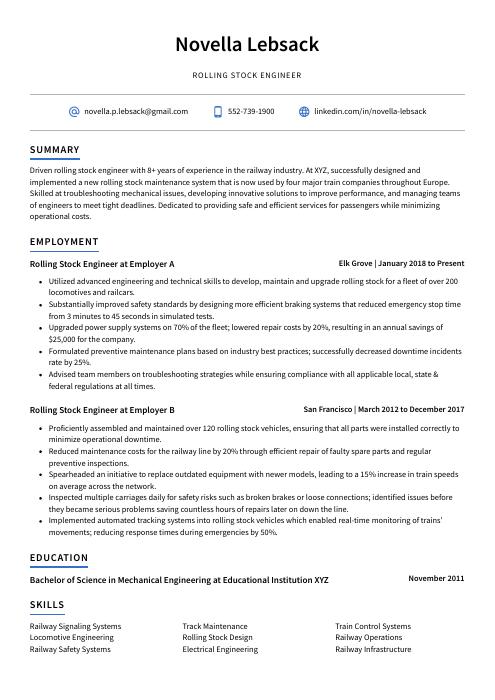 Axolotl
Axolotl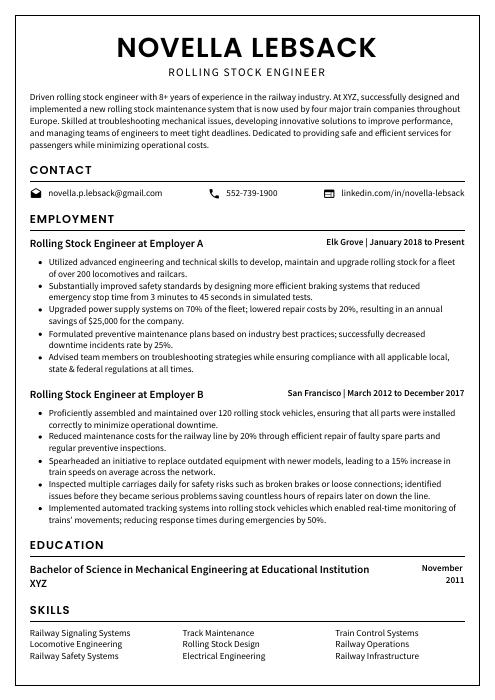 Cormorant
Cormorant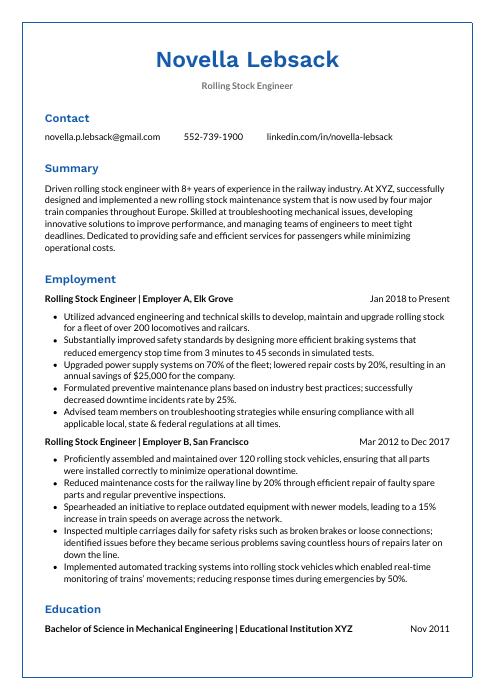 Markhor
Markhor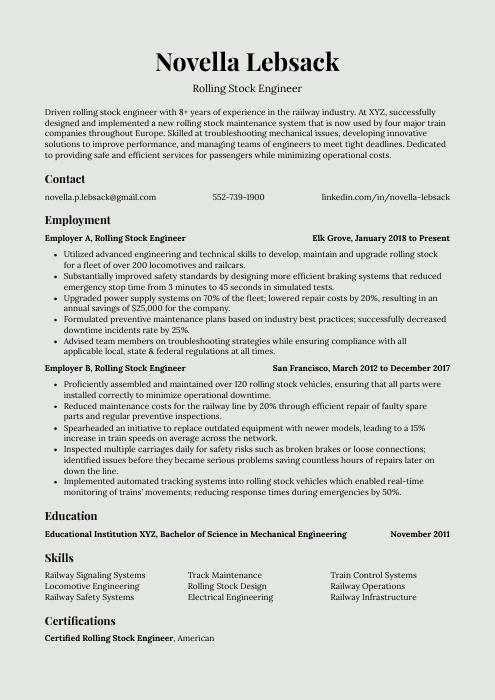 Saola
Saola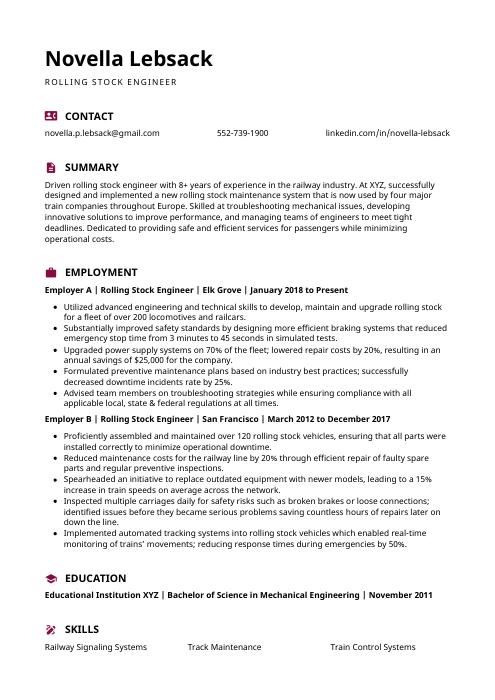 Hoopoe
Hoopoe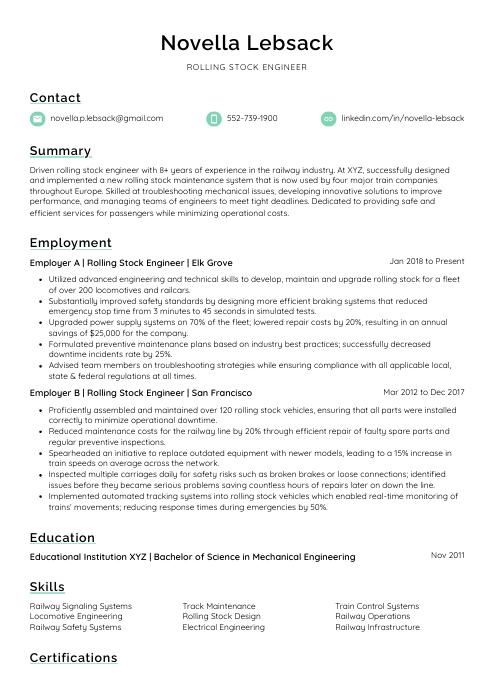 Lorikeet
Lorikeet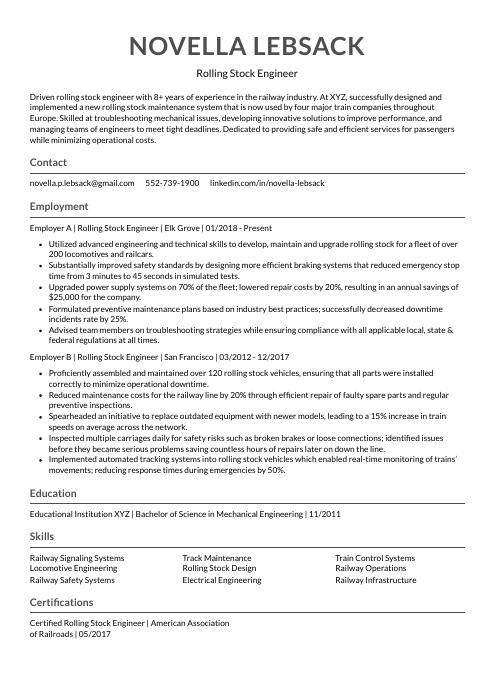 Indri
Indri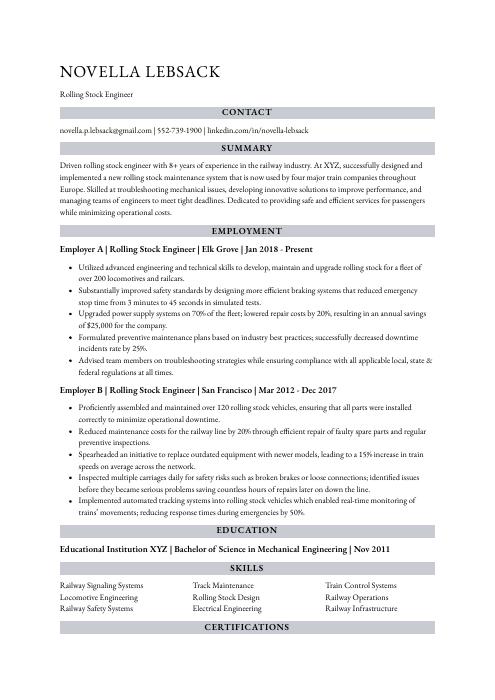 Numbat
Numbat Rezjumei
Rezjumei
